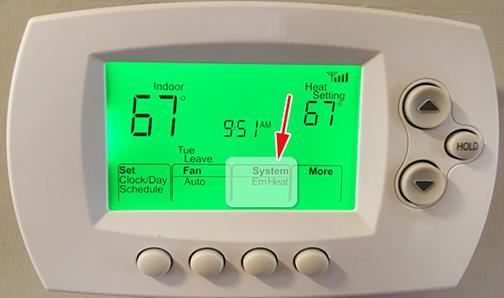There’s no better way to achieve an ideal microclimate for your home using a heat pump than a simple trial and error method until you find the perfect settings to strike a balance between energy efficiency and home comfort.
Since homes have different heat loss or retention properties, even within the same location, and it’s difficult to choose the specific best heat pump thermostat settings that apply for each home.
However, the Department of Energy recommends setting your heat pump to 78°F during the summer and 68°F throughout the winter. This article explains further why these are the best heat pump thermostat settings for your home.
Best Heat Pump Thermostat Settings
Heat pumps are mainly used for two purposes – heating in winter and cooling in summer. The thermostat settings you choose for the heat pump depend on these two seasons and what the pump has to do in each of the seasons.
What Temperature Should I Set My Heat Pump to in Winter?
It’s advisable to set your heat pump to 68°F during winter for the heat mode when you are at home during the day. Setting the heat pump to lower temperatures in winter saves you more money if you live in a milder climate than someone living in an extreme climate.
68°F is the perfect temperature that ensures your auxiliary heat system (such as electric heat strips) does not turn on. Auxiliary heat systems dependent on electric resistance heating consume a lot of energy during heating, cranking up your heating bills.
You can set the thermostat lower to 64-67°F when sleeping and 62°F when you are away from home for at least six hours. If you are at home most of the time on colder days when temperatures outside are 32°F or less, you can set your heat pump to 70-72°F – minimum.
What Temperature Should I Set My Heat Pump to in Summer?
You need the heat pump for round-the-clock cooling in summer. The ideal temperature to set the heat pump to in summer is 78°F for the cooling mode during the day when you are at home.
When you are asleep, you can set the heat pump a bit higher to save about 5-8% on your heat bills.
If you are away from home for at least six hours, it’s advisable to set the thermostat to a higher temperature such that the cooling system initiates at 88°F.

Factors That Affect Your Heat Pump Settings
As noted earlier, different homes have varying internal environments even within the same locality. As such, several factors dictate the heat pump settings you should set for your home. Here’s a breakdown of the factors.
Outdoor Temperature
You should set your heat pump to achieve a temperature as close as possible to the prevailing outdoor temperature. However, it’s important to note that heat pumps lose efficiency as outside temperatures keep dipping, and below 40°F is on the lower side.
Since they transfer heat rather than generate it, heat pumps take much longer to achieve the temperatures you set for your home.
If there is a huge discrepancy between the prevailing indoor and outdoor temperatures, the pump will take more time to bridge the difference to the set thermostat temperature. And it has to labor more while at it.
Humidity Level
Manage the level of indoor humidity alongside heat pump thermostat settings. When the humidity is too high, no temperature will be comfortable for you.
While 30-60% humidity is comfortable for most people, it is recommended that the humidity range for your home should be 45-55% for better management of illnesses and health effects. Anything above 60% is on the higher side and can be fatal in some situations.
In winter, indoor humidity levels should be 40% or lower to reduce the build-up of excessive condensation on the windows, another heat loss threat for your home.
Time Spent at Home or Away
You want your heat pump to provide the best cooling and heating when you are at home. Set the thermostat to 78°F when you are at home during the day in summer and 68°F for the same in winter.
If you leave the house for at least six hours, set the heat pump higher to start cooling at 88°F in summer and 62°F in winter.
Time Spent Sleeping or Awake
When awake in the house, the heat pump settings should be the same as when you spend time at home – 78°F for summer and 68°F for winter.
When sleeping in the summer, you can set the thermostat higher than 78°F for more cooling whenever required. In winter, you can set the heat pump to 64-67°F in the heat mode when sleeping.

Tips and Tricks to Maximizing Your Heat Pump’s Efficiency
Several measures are applicable when you want to increase the efficiency of your heat pump at cooling and heating your home. The best route to follow is to combine the different tricks and tips below for even better results.
Regular Maintenance
A properly maintained heat pump will always beat a poorly maintained one hands down in efficiency.
Some common heat pump maintenance practices include changing or cleaning air filters monthly, restoring refrigerant charge, and removing ice on the outdoor unit during winter.
Using a Fan
A portable fan comes in handy in improving heat pump efficiency by ensuring proper air circulation even in hidden places. With proper air circulation, the heat pump doesn’t have to overwork to heat or cool your home, depending on what mode you set it.
Adding Insulation and Sealing Cracks
Cracked exterior walls in your house facilitate heat entry in the summer and heat loss in the winter. Consider sealing off any existing cracks to keep these two situations in check.
If you have a central air conditioning system, ensure all the ducts are properly insulated to reduce heat loss in the winter or excessive heat gain in the summer.
Opening and Closing Curtains
Opening the curtains of south-facing windows during the day allows as much sunlight into the home. Daw them back at night to reduce the entry of cold air and heat loss caused by condensation on the windows.
Using a Programmable Thermostat
Unlike traditional models that require manually setting temperatures every time, programmable thermostats allow you to set the temperature you want for your heat pump even in advance for scheduled cooling and heating.
Temperature adjustments of 5-8 degrees higher in summer and lower in winter can lead to higher efficiency and lower energy consumption by the heat pump, translating into reduced power bills.
The catch with programmable thermostats is that not all will work with any heat pump system. You should consult your trusted HVAC professional for advice on the best-suited thermostat for your system.

Setting the Heat Pump Fan to Auto Mode
The recommended auto mode of the heat pump fan should not be confused with the auto mode of the heat pump itself, not recommended if you want efficient cooling and heating. The heat pump fan operates on either ON or AUTO FAN.
The auto fan mode boosts the heat pump’s efficiency since the blower fan in this position only runs when the heat pump needs it most for air circulation instead of running all the time in the ON position.
Conclusion
The recommended best heat pump thermostat settings are 68°F in winter and 78°F in summer. However, your home might have different heating and cooling needs, prompting you to tweak the settings until you find the sweet spot between efficiency and comfort.
Although setting the best temperature may be trial and error, avoid frequent changes. They trip the pump out of balance. You should find a comfortable temperature and leave the pump alone. Otherwise, the recommended 68 and 78°F are your best bet.

